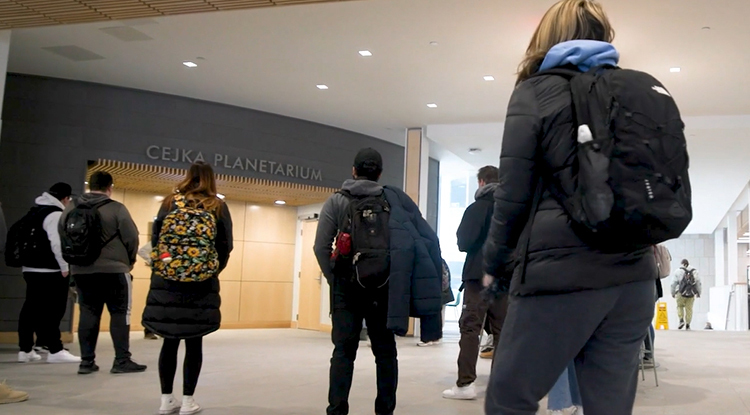Indiana University of Pennsylvania’s Cejka Planetarium, in the university’s newly opened John J. and Char Kopchick Hall, will host three shows during the spring semester, all free and open to the community.
 The upcoming shows are “Astronomy and Calendars” on February 19 at 7:00 p.m., examining what astronomy has to do with calendars; “The American Total Solar Eclipse of 2024” on March 7 and March 18 at 7:00 p.m. and on March 30 at 11:00 a.m.; and “Far from Home: Perseverance on Mars” on May 14 at 7:00 p.m.
The upcoming shows are “Astronomy and Calendars” on February 19 at 7:00 p.m., examining what astronomy has to do with calendars; “The American Total Solar Eclipse of 2024” on March 7 and March 18 at 7:00 p.m. and on March 30 at 11:00 a.m.; and “Far from Home: Perseverance on Mars” on May 14 at 7:00 p.m.
The March shows about the eclipse will discuss one of the rarest astronomical events, a total solar eclipse, which will not happen again until 2045. The May show about the Mars rover Perseverance will discuss the discoveries (aided by a helicopter) that the rover is making and how it is changing our understanding of Mars.
The shows are sponsored by the IUP Department of Geography, Geology, Environment, and Planning and the IUP Kopchick College of Natural Sciences and Mathematics. The shows are developed and presented by Ken Coles, planetarium director and professor of geography, geology, environment, and planning.
The Cejka Planetarium is located on the second floor (Oak Grove level) of IUP’s Kopchick Hall, the university’s new $90-million science facility, which opened for classes for the spring semester.
After the shows, weather permitting, telescope observing of the night sky (evening shows) or of the sun (daytime shows) will be available. Seating is limited; doors will open 15 minutes before each show. Groups that wish to attend are asked to call 724-357-5626 or 724-357-2379 in advance of the shows.
IUP’s planetarium in Weyandt Hall, former home to the Kopchick College, featured a Spitz A3P projector. The Weyandt Hall planetarium was in use for classes and community presentations for 56 years.
The Cejka Planetarium, named in honor of the generosity of Tim and Debra Phillips Cejka, 1973 graduates of IUP, features a digital projector.
“With the Cejka Planetarium’s digital projector, there is absolutely no limit to the programs and educational opportunities that we can provide,” Coles said. “It can be used for so many other teaching applications outside of astronomy, including disciplines outside the sciences. You can fly over the Earth or other planets; you can offer a magnified view of items; you can literally create an environment that surrounds you. When you are looking at something on a dome, it’s very different than seeing something flat,” he said.
In addition to the advantages offered by a digital projector connected to the internet in the Cejka Planetarium, the new projector offers a higher resolution and speed in a larger setting; the dome in the Cejka Planetarium is 35 feet, compared to the Weyandt Planetarium dome of 30 feet. The Cejka Planetarium also offers more seating than the Weyandt facility.
The IUP Council of Trustees approved the naming of the new planetarium in honor of the Cejkas in May 2018. Tim Cejka, who is now a member of the IUP Council of Trustees, is the retired president of ExxonMobil Exploration Company and vice president of ExxonMobil Corp.
The Cejka’s $2-million donation completed the match required from the university by the Department of General Services to move forward with the Kopchick Hall project. The Cejka’s $2-million gift joined their $5-million donation to IUP as part of the university’s Imagine Unlimited comprehensive campaign.
Kopchick Hall and the Kopchick College are named in honor of IUP graduates John and Char Labay Kopchick. Long-time IUP supporters, the Kopchicks made a $23-million donation to IUP in April 2018 for science and mathematics initiatives at IUP. John Kopchick earned his bachelor’s and master’s degrees from IUP in 1972 and 1975, respectively; Char Kopchick graduated from IUP in 1973.
IUP formally cut the ribbon for the $90-million building on November 2, 2023. Weyandt Hall will be razed in the spring.
“Because we believe so strongly in the value of science education, and in IUP, we were committed to making a gift to Kopchick Hall and we wanted to help to create something very special, a showpiece within the building, that would meet the needs of current and future students and faculty, and attract potential students,” Tim Cejka said.
“This new planetarium will open up so many horizons—it could even be used for students entering the teaching field, providing the immersive experience of a classroom to help pre-teachers to be better prepared for the student teaching experience,” he said.
“If something is available on a digital platform, you can access it and use it in the planetarium,” Tim Cejka said. “It’s a great teaching tool for almost every discipline beyond astronomy and earth science, which it will do very, very well,” he said.